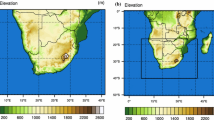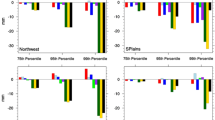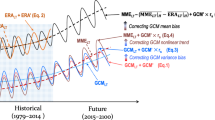Abstract
Simulations of the East Asian summer monsoon for the period of 1979–2001 were carried out using the Weather Research and Forecast (WRF) model forced by three reanalysis datasets (NCEP-R2, ERA-40, and JRA-25). The experiments forced by different reanalysis data exhibited remarkable differences, primarily caused by uncertainties in the lateral boundary (LB) moisture fluxes over the Bay of Bengal and the Philippine Sea. The climatological mean water vapor convergence into the model domain computed from ERA-40 was about 24% higher than that from the NCEP-R2 reanalysis. We demonstrate that using the ensemble mean of NCEP-R2, ERA-40, and JRA-25 as LB forcing considerably reduced the biases in the model simulation. The use of ensemble forcing improved the performance in simulated mean circulation and precipitation, inter-annual variation in seasonal precipitation, and daily precipitation. The model simulated precipitation was superior to that in the reanalysis in both climatology and year-to-year variations, indicating the added value of dynamic downscaling. The results suggest that models having better performance under one set of LB forcing might worsen when another set of reanalysis data is used as LB forcing. Use of ensemble mean LB forcing for assessing regional climate model performance is recommended.







Similar content being viewed by others
References
Adler RF, Huffman GJ, Bolvin DT et al (2000) Tropical rainfall distributions determined using TRMM combined with other satellite and rain gauge information. J Appl Meteorol 39:2007–2023
Adler RF, Huffman GJ, Chang A et al (2003) The version-2 global precipitation climatology project (GPCP) monthly precipitation analysis (1979-present). J Hydrometeorol 4:1147–1167
Anthes RA, Kuo YH, Baumhefner DP, Errico RM, Bettge TW (1985) Predictability of mesoscale atmospheric motions. Issues in atmospheric and oceanic modeling. Advances in geophysics, vol 28B. Academic Press, pp 159–202
Chen F, Dudhia J (2001) Coupling an advanced land surface-hydrology model with the Penn State-NCAR MM5 modeling system. Part I: model implementation and sensitivity. Mon Weather Rev 129:569–585
Chen S-H, Sun W-Y (2002) A one-dimensional time dependent cloud model. J Meteorol Soc Jpn 80:99–118
Christensen JH, Machenhauer B, Jones RG, Schar C, Ruti PM, Castro M, Visconti G (1997) Validation of present-day regional climate simulations over Europe: LAM simulations with observed boundary conditions. Climate Dyn 13:489–506
Christensen OB, Christensen JH, Machenhauer B, Botzet M (1998) Very-high-resolution regional climate simulations over Scandinavia present climate. J Clim 11:3204–3229
Denis B, Laprise R, Caya D, Cote J (2002) Downscaling ability of one-way nested regional climate models: the big-brother experiment. Climate Dyn 18:627–646
Diaconescu EP, Laprise R, Sushama L (2007) The impact of lateral boundary data errors on the simulated climate of a nested regional climate model. Climate Dyn 28:333–350
Ding Y, Sikka DR (2006) Synoptic systems and weather. In: Wang B (ed) The asian monsoon. Springer, Berlin, pp 131–202
Douville H, Chauvin F, Broqua AH (2001) Influence of soil moisture on the Asian and African monsoons. Part I: mean monsoon and daily precipitation. J Clim 14:2381–2403
Dudhia J (1989) Numerical study of convection observed during the winter monsoon experiment using a mesoscale two-dimensional model. J Atmos Sci 46:3077–3107
Fu C-B, Wang S-Y et al (2005) Regional climate model intercomparison project for Asia. Bull Am Meteorol Soc 86:257–266
Giorgi F, Bi X (2000) A study of internal variability of a regional climate model. J Geophys Res 105:29503–29521
Giorgi F, Mearns LO (1999) Introduction to special section: regional climate modeling revisited. J Geophys Res 104:6335–6352
Gustafsson N (2002) Sensitivity of limited area model data assimilation to lateral boundary condition fields. Tellus A 42:109–115
Jacob D, Podzun R (1997) Sensitivity studies with the regional climate model REMO. Meteorol Atmos Phys 63:119–129
Janjic ZI (2000) Comments on ‘‘development and evaluation of a convection scheme for use in climate models’’. J Atmos Sci 57:3686
Kanamitsu M, Ebisuzaki W, Woollen J, Yang S-K, Hnilo JJ, Fiorino M, Potter GL (2002) NCEP-DOE AMIP-II reanalysis (R-2). Bull Am Meteorol Soc 83:1631–1643
Krishnamurti TN, Kishtawal CM, LaRow TE, Bachiochi DR, Zhang Z, Williford CE, Gadgil S, Surendran S (1999) Improved weather and seasonal climate forecasts from multi-model superensemble. Science 285:1548–1550
Leung LR, Ghan SJ (1999) Pacific Northwest climate sensitivity simulated by a regional climate model driven by a GCM. Part I: control simulations. J Clim 12:2010–2030
Liang X-Z, Kunkel KE, Samel AN (2001) Development of a regional climate model for US midwest applications. Part I—sensitivity to buffer zone treatment. J Clim 14:4363–4378
Lin Y-L, Farley RD, Orville HD (1983) Bulk parameterization of the snow field in a cloud model. J Clim Appl Meteorol 22:1065–1092
Miyakoda K, Rosati A (1977) One way nested grid models: the interface conditions and the numerical accuracy. Mon Weather Rev 105:1092–1107
Mlawer EJ, Taubman SJ, Brown PD et al (1997) Radiative transfer for inhomogeneous atmosphere: RRTM, a validated correlated-k model for the longwave. J Geophys Res 102:16663–16682
Mohanty UC, Paliwal RK et al (1990) Evaluation of a limited area model for short range prediction over Indian region: sensitivity studies. Mausam 41:251–256
Noh Y, Cheon WG, Hong SY, Raasch S (2003) Improvement of the K-profile model for the planetary boundary layer based on large eddy simulation data. Bound Layer Meteor 107:401–427
Onogi K, Tsutsui J, Koide H et al (2007) The JRA-25 reanalysis. J Meteorol Soc Jpn 85:369–432
Paegle J, Yang Q, Wang M (1997) Predictability in limited area and global models. Meteorol Atmos Phys 63:53–69
Palmer TN, Brankovic C, Richardson DS (2000) A probability and decision-model analysis of PROBOST seasonal multi-model ensemble integrations. Q J R Meteorol Soc 126:2013–2034
Pan Z, Christensen JH, Arritt RW, Gutowski WJ Jr, Takle ES, Otieno F (2001) Evaluation of uncertainties in regional climate change simulations. J Geophys Res 106:17735–17751
Qian Y-F, Liu H-Q (2001) On nesting area selection of regional climate models coupled to a global climate model (in Chinese). Chin J Atmos Sci 25:492–502
Shukla J, Anderson J, Baumhefner D et al (2000) Dynamical seasonal prediction. Bull Am Meteorol Soc 81:2593–2606
Skamarock WC, Klemp JB, Dudhia J et al (2005) A description of the advanced research WRF version 2. NCAR tech notes-468 + STR
Takle ES, Gutowski WJ Jr, Arritt RW et al (1999) Project to intercompare regional climate simulations (PIRCS): description and initial results. J Geophys Res 104:19443–19461
Uppala SM, Kallberg PW, Simmons AJ et al (2005) The ERA-40 re-analysis. Q J Roy Meteorol Soc 131:2961–3012
Vukicevic T, Errico RM (1990) The influence of artificial and physical factors upon predictability estimates using a complex limited-area model. Mon Weather Rev 118:1460–1482
Wang B, Yang H-W (2008) Hydrological issues in lateral boundary conditions for regional climate modeling: simulation of east asian summer monsoon in 1998. Clim Dyn 31:477–490
Wang Y, Sen OL, Wang B (2003) A highly resolved regional climate model (IPRC-RegCM) and its simulation of the 1998 severe precipitation event over China. Part I: model description and verification of simulation. J Clim 16:1721–1738
Wang B, Kang I-S, Lee J-Y (2004) Ensemble simulations of Asian–Australian monsoon variability by 11 AGCMs. J Clim 17:803–818
Wu W, Lynch AH, Rivers A (2005) Estimating the uncertainty in a regional climate model related to initial and lateral boundary conditions. J Clim 18:917–933
Xue Y, Vasic R, Janjic Z, Mesinger F, Mitchell KE (2007) Assessment of dynamic downscaling of the continental U.S. Regional climate using the eta/ssib regional climate model. J Clim 20:4172–4193
Yatagai A, Arakawa O, Kamiguchi K, Kawamoto H, Nodzu MI, Hamada A (2009) A 44-year daily gridded precipitation dataset for Asia based on a dense network of rain gauges. SOLA 5:137–140. doi:10.2151/sola.2009-035
Zhou T-J, Yu R-C (2005) Atmospheric water vapor transport associated with typical anomalous summer rainfall patterns in China. J Geophys Res 110:D08104. doi:10.1029/2004JD005413
Acknowledgments
Hongwei Yang acknowledges joint support from the 973 Project (2010CB428403), 863 Project (2010AA012301), and LASG State Key Laboratory Special fund. Bin Wang at the University of Hawaii acknowledges support by APEC Climate Center (APCC) and the Korean meteorological Administration Research and Development Program under Grant RACS 2010-2017. The authors would also like to thank two anonymous reviewers of this paper for their useful and insightful comments.
Author information
Authors and Affiliations
Corresponding author
Rights and permissions
About this article
Cite this article
Yang, H., Wang, B. & Wang, B. Reduction of systematic biases in regional climate downscaling through ensemble forcing. Clim Dyn 38, 655–665 (2012). https://doi.org/10.1007/s00382-011-1006-4
Received:
Accepted:
Published:
Issue Date:
DOI: https://doi.org/10.1007/s00382-011-1006-4




